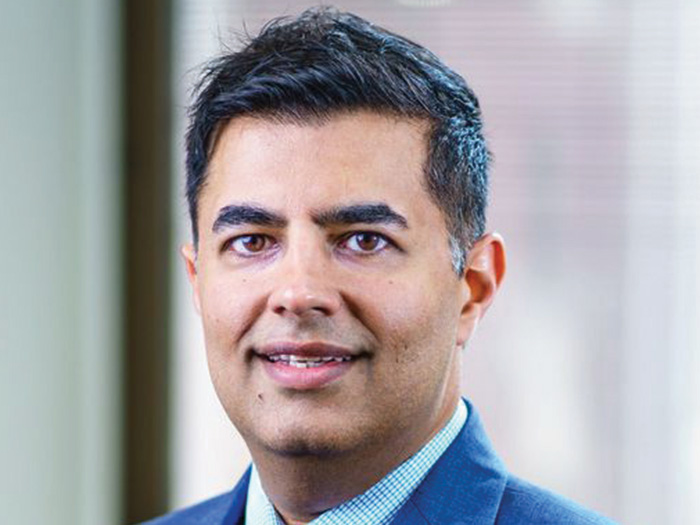Navigating Construction Risks and Insurance in an Era of Mega Projects

At the 2024 RISKWORLD conference in San Diego, Risk & Insurance sat down with Adrian Pellen, Managing Director & Co-Leader of the North American Construction & Infrastructure Group at NFP, to discuss the macro trends in construction and infrastructure, the role of data and technology in risk mitigation, and the potential blind spots in the construction insurance sector.
What follows is a transcript of that conversation, edited for length and clarity.
Risk & Insurance: Tell me about your role at NFP and what is the company’s primary focus and vision?
Adrian Pellen: Our primary focus and vision at NFP is to be a risk control driven brokerage. We help clients with their operational, contractual, and technology risk controls. The goal is to assist them in obtaining better insurance pricing or reducing deductibles.
As an insurance broker, our primary focus is on providing comprehensive risk management solutions rather than replacing the role of consultants. We strive to go beyond traditional insurance broking by taking a holistic view of our clients’ risks.
Essentially, we help clients quantify their risk mitigation delta, which involves making investments in technology from the outset. By doing so, we enable them to effectively mitigate risks and optimize their insurance coverage.
R&I: What are some of the most significant macro trends you’ve observed in the construction and infrastructure space over the past few years, and where do you think we are in the context of those trends?
AP: We’re currently witnessing extraordinary investment in infrastructure, driven by factors such as the pandemic and geopolitical tensions, particularly between the United States and China. The Infrastructure Investments and Jobs Act and the Inflation Reduction Act are spurring investment in areas like energy transition.
Additionally, the CHIPS Act is focused on self-sufficiency, addressing the supply chain disruptions experienced during the pandemic, with a particular emphasis on semiconductor processing. As a result, the construction industry is experiencing an enormous boom.
The pandemic highlighted the vulnerabilities in global supply chains. This, coupled with the strained US-China relations, has led to increased investment in domestic semiconductor production. The goal is to enhance self-sufficiency in meeting the growing demand for semiconductors, which are crucial components in various devices and industries, including renewable energy.
R&I: What are the key challenges and opportunities in the current market for large-scale construction projects?
AP: The current market presents enormous opportunities from a competitive perspective, with significant investments driving growth in the construction industry. However, this also creates challenges on the risk management side.
Mega projects — projects with a value around $1 billion or more — are becoming increasingly common, pose significant risks due to their sheer scale. This is compounded by the rising cost of insurance, driven by factors such as social inflation, climate change, and wildfires. As a result, projects often end up being underinsured or the level of insurance required becomes cost-prohibitive.
To address these challenges, our focus is on developing robust risk control measures. Rather than simply purchasing the maximum amount of insurance available in the market, we are investing significant energy in identifying and mitigating potential risks associated with these large-scale projects.
R&I: What types of infrastructure projects are seeing significant investment in the current market?
AP: We’re witnessing substantial investments in various infrastructure projects across the country. In rapidly growing urban centers like Nashville and Austin, there is a surge in new infrastructure development.
Meanwhile, many major cities in the Northeast are focusing on revitalizing their core infrastructure. A prime example is the multibillion-dollar, multi-stage Gateway Project in New York, which aims to replace and upgrade railway infrastructure with new tunnels across the Hudson River.
Another area of significant investment is water infrastructure, driven by events like the water crisis in Flint, Michigan. This includes projects related to water transmission, distribution, and purification, particularly in expanding cities and centers. Arizona, for instance, is placing a strong emphasis on water purification infrastructure.
R&I: How is the construction insurance industry benefitting from collecting more data, and what types of data are being collected and managed with Risk Management Information Systems (RMIS)?
AP: This is an area of personal excitement for me and one of the pillars of our group. We’ve set up a task force to focus on supporting clients with their data architecture. Historically, the insurance and construction sectors have sat on a lot of unstructured data. We’ve been spending a great deal of time trying to figure out how to better structure it so that we can collect the right data to gain the right insights.
RMIS have really evolved. Historically, they primarily supported claims infrastructure, from reporting to managing claims throughout their life cycle. Now, RMIS have expanded tremendously to capture not just claims data but also exposure information.
Tying in front-end accounting with claims is a big piece. On the exposure side, key information includes the asset class (e.g., bridge, road, tunnel, solar plant), project size and value, and location. Excitingly, clients are looking at RMIS as a way to create incentives for people in the field. The more data they collect, the better insights they have, allowing for more calculated decision-making.
Data capture and collection provide contractors with valuable insights to make more calculated decisions about the risks they are willing to take on. By tracking information at the field level, contractors can create incentives for their teams and determine if their bets pay off.
Beyond claims and exposure information, RMIS platforms are evolving to capture data on risk control investments and decisions at both the enterprise and project-specific levels. For example, in a building project, contractors can track the implementation of IoT technology for leak detection and prevention, which is a significant issue in the builders risk insurance space.
By capturing this data in the RMIS, contractors can run regression analyses to determine the actual impact of these investments. This allows them to rationalize their spending and decide whether to implement similar measures on future projects.
There is a growing trend of insurtech and construction technology companies offering new ideas, services, and technologies claiming to save premiums. However, these claims are largely unproven. To address this, we have built a technology alliance to inventory what these technology firms offer and educate the field, enabling us to track the implementation of these technologies and quantify the risk mitigation delta.
R&I: Various factors are driving up project values and risk exposures. Are these also impacting the quality of the final product and contractor performance? What types of insurance do clients need to protect themselves?
AP: The pandemic and supply chain volatility have primarily affected the timeliness of project delivery. The industry has largely done a good job of rebalancing the risk equilibrium, determining who shares responsibility for certain risks, particularly in mega projects where there is significant attention.
We’re seeing more shared risk, with contractors not solely responsible for everything. It’s becoming more common for owners to provide mobilization payments to contractors to help manage supply chain issues and equipment procurement, rather than only paying when certain milestones are reached.
From a risk management perspective, there is a big emphasis on surety, which provides performance security for contractors to owners. Negotiations are taking place around appropriate bonding levels given project size. Projects are also being done as joint or tri-ventures to spread the risk of performance default.
Another layer is ensuring subcontractors are paid through payment bonds, so they are compensated if the contractor defaults. These instruments are being implemented more frequently.
Additionally, given talent shortages, there is a focus on subcontractor default insurance, assessing not just the financial wherewithal of the sub, but also their operational procedures. Contractors can bet on themselves in this area by funding a deductible vehicle within the program based on their own evaluation processes.
R&I: What are the key challenges and concerns in the construction insurance sector that keep you up at night?
AP: There are several pressing issues in the construction insurance sector currently. One major challenge is the trend of mega projects, which are becoming increasingly larger in scale. Insuring these projects against catastrophic perils like flood, wildfire, earthquake, or windstorm is becoming cost-prohibitive due to insufficient insurance capacity.
Another issue is the complexity of dealing with numerous stakeholders in these projects, such as government entities and lenders. Each stakeholder has their own requirements, which often leads to incongruencies that make navigating the process commercially challenging.
Additionally, while the construction insurance sector remains a relationship-driven business, the rapid emergence of new technologies like generative AI raises questions about potential disruption. Although I don’t worry excessively about this given the importance of relationships, I believe these technologies could be powerful complements to our daily operations, such as risk due diligence, broking, and underwriting.
The concern lies in ensuring that we are among the first movers in harnessing these technologies effectively. Staying ahead of the curve in adopting and leveraging these advancements is an area of both excitement and apprehension regarding their potential impact on the industry.
R&I: What success stories in the industry have you seen that others be looking to emulate?
AP: In our industry, there has been a significant push towards leveraging technology for risk management and underwriting, a trend we largely align with as well. We’re seeing numerous new MGAs and insurance companies, both traditional and large retail ones, either providing rate and deductible credits for technologies that construction companies or owners are implementing on their projects or even paying for the technologies themselves.
Finding the right underwriting talent is a critical focus for me. The U.S. construction market is vast, and we’re seeing an influx of international construction companies looking to capitalize on investments from the Infrastructure and Jobs Act and the CHIPs Act. These companies are coming from various regions, including Japan, Korea, Western and Central Europe, and Latin America.
Interestingly, many of these projects haven’t been undertaken in the U.S. in recent history, but other parts of the world have experience with them. This has transformed the construction industry into a truly global underwriting market. We dedicate significant time and resources to mapping underwriting expertise for projects such as offshore wind or tunnels.
Ultimately, the industry is heading towards a more global approach, and it’s not just about finding opportunities, but also about locating the best underwriting talent to support these projects. &











